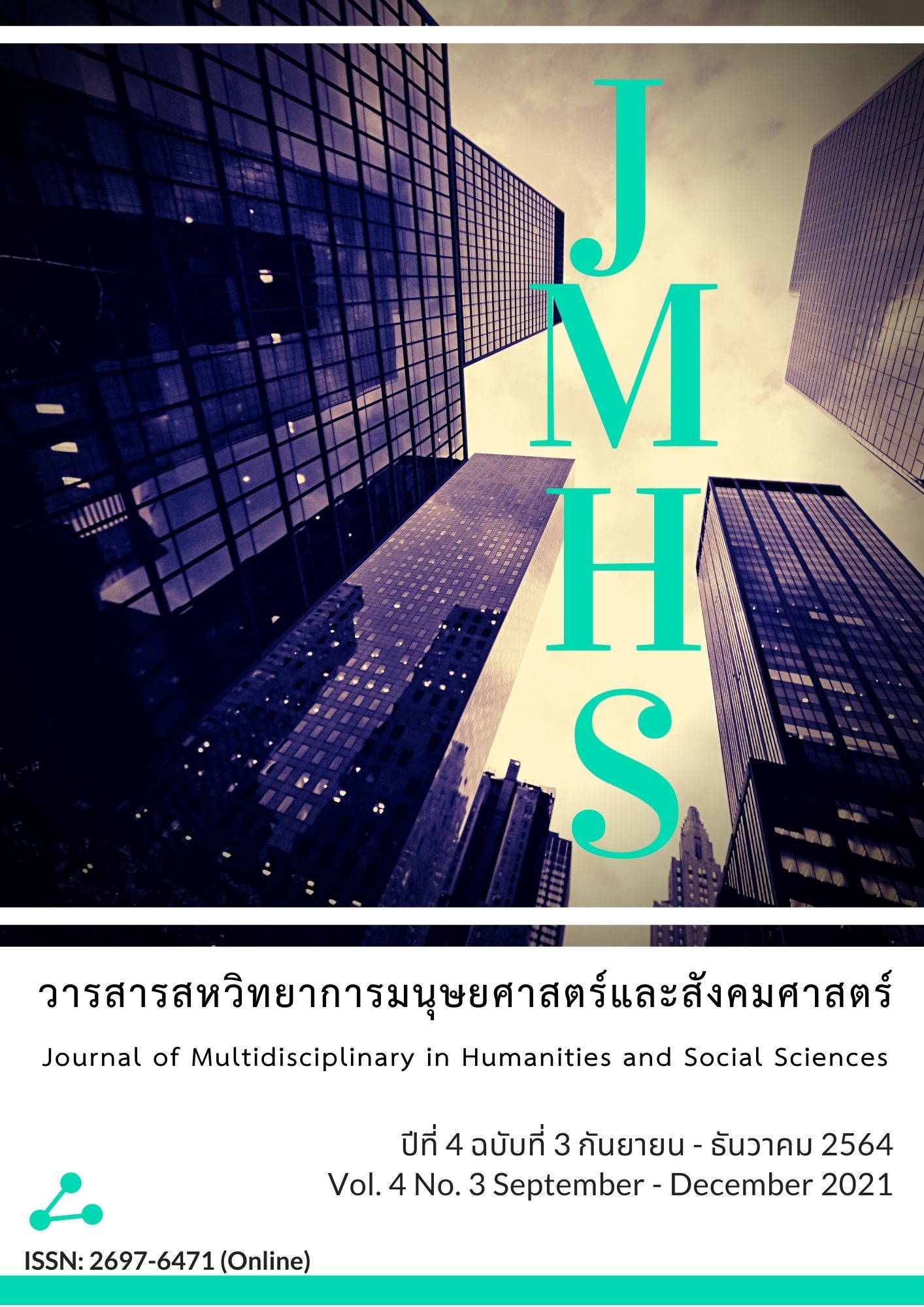Factors affecting intention to use residential solar photovoltaic technology in Bangkok
Main Article Content
Abstract
Currently, solar energy has received attention for producing electricity as a substitute for natural fuel resources to reduce environmental emissions and fulfill the higher demand of electricity consumption. This article aimed to 1) study the factors of technology acceptance that influence the intention of using residential solar photovoltaic technology in Bangkok; and 2) study safety factors and external factors that influence the intention of using residential solar photovoltaic technology in Bangkok. This study was quantitative research. The use of the technology acceptance model was used as the main research framework. The research was conducted in the Bangkok area. Participants were selected based on their interest in using solar cell technology in their residential area. The correlated data were collected from 400 participants who finished a questionnaire that used ‘random sampling’ method. The statistics which were used for analyzing data were frequency, percentage, mean, standard deviation, Pearson’s correlation coefficient, and multiple regression analysis.
The results revealed that the level of opinion safety factors was the highest level of (= 4.39, S.D. = 0.56). When classified into each aspect by sorting the average from highest to lowest, technology acceptance, perceived usefulness factors (
= 4.26, S.D. = 0.60). Moreover, the external factors consist of government policies, the trend of electricity change rate, the demand for electricity, the maintenance cost, and the payback period (
= 4.21, S.D. = 0.61) and the technology acceptance and perceived ease of use factors (
= 4.02, S.D. = 0.74). For multiple regression analysis, the results showed that all independent factors had an influence on the intention of use and described the tendency of the intention of use at 61.40 percent.
Article Details
Views and opinions appearing in the Journal it is the responsibility of the author of the article, and does not constitute the view and responsibility of the editorial team.
References
กรมพัฒนาพลังงานทดแทนและอนุรักษ์พลังงาน, กระทรวงพลังงาน. (2554). คู่มือการพัฒนาและลงทุนผลิตพลังงานทดแทน “พลังงานแสงอาทิตย์”. กรุงเทพฯ: กระทรวงพลังงาน.
ฐิตาพร แสงนาค. (2563). แรงจูงใจที่ส่งผลต่อการตัดสินใจติดตั้งเซลล์แสงอาทิตย์บนหลังคาและระบบกักเก็บพลังงานในระดับครัวเรือนในภาคกลางของประเทศไทย(สารนิพนธ์ปริญญามหาบัณฑิต). มหาวิทยาลัยมหิดล.
ปราโมทย์ ลือนาม. (2554). แนวความคิดและวิวัฒนาการของแบบจำลองการยอมรับการใช้เทคโนโลยี. วารสารการจัดการสมัยใหม่, 9(1), 11-12.
สำนักงานนโยบายและแผนพลังงาน, กระทรวงพลังงาน. (2563). แผนพัฒนากำลังผลิตไฟฟ้าของประเทศไทย พ.ศ. 2561 - 2580. กรุงเทพฯ: กระทรวงพลังงาน.
สำนักงานสถิติแห่งชาติ. (2563). รายงานผลการสำรวจข้อมูลพื้นฐานของครัวเรือน พ.ศ. 2563 ทั่วราชอาณาจักร. กรุงเทพฯ: กระทรวงดิจิทัลเพื่อเศรษฐกิจและสังคม.
Ahmad, S., Mat Tahar, R. B., Cheng, J. K., & Yao, L. (2017), Public Acceptance of Residential Solar Photovoltaic Technology in Malaysia. PSU Research Review, 1(3), 242-254. https://doi.org/10.1108/PRR-11-2016-0009
Ali, S., Poulova, P., Akbar, A., Javed, H.M.U., & Danish, M. (2020). Determining the Influencing Factors in the Adoption of Solar Photovoltaic Technology in Pakistan: A Decomposed Technology Acceptance Model Approach. Economies, 8(4), 108. doi:10.3390/economies8040108
Cai, Desmond W.H., Adlakha, S., Low, Steven H., De Martini, P., & Mani Chandy, K. (2013). Impact of Residential PV Adoption on Retail Electricity Rates. Energy Policy, 62(C), 830-843.
Chen, S-C., Li, S-H., & Li, C-Y. (2011). Recent Related Research in Technology Acceptance Model: Literature Review. Australian Journal of Business and Management Research, 1(9), 124-127.
Davis, F. D. (1989). Perceived Usefulness, Perceived Ease of Use, and User Acceptance of Information Technology. MIS Quarterly, 13(3), 319-340. https://doi.org/10.2307/249008
Kannan, R., Leong, K.C., Osman, R., Ho, H.K., & Tso, C.P. (2006). Life Cycle Assessment Study of Solar PV Systems: An Example of a 2.7 kWp Distributed Solar PV System in Singapore. Solar Energy, 80(5), 555-563. https://doi.org/10.1016/j.solener.2005.04.008
Kim, J. K. (2019). Multicollinearity and Misleading Statistical Results. Korean J Anesthesiol, 72(6), 558-569. https://doi.org/10.4097/kja.19087
Lee, B., Trcka, M., & Hensen, J. L. M. (2013). Rooftop Photovoltaic (PV) Systems: A Cost-benefit Analysis Study of Industrial Halls. International Journal of Low-Carbon Technologies, 319–326. https://doi.org/10.1093/ijlct/ctt008
Magoon, K A. (2020). Solar Energy for the People of North Carolina: Net Metering After the Competitive Energy Solution ACT of 2017. The Elon Law Journal, 12(1), 175-201. https://www.elon.edu/u/law/wp-content/uploads/sites/996/2020/06/Magoon.pdf
Nabilah, L. S., Loveldy, Z. A. C., Prayoga, S. S., & Suhartanto, D. (2019). Solar House System Adoption among Rural Community. IOP Conf. Series: Materials Science and Engineering, 662(4). DOI:10.1088/1757-899X/662/4/042024
Owusu, P.A., & Asumadu-Sarkodie, S. (2016). A Review of Renewable Energy Sources, Sustainability Issues and Climate Change Mitigation. Cogent Engineering, 3(1), 1-14. https://doi.org/10.1080/23311916.2016.1167990
Ratner, B. (2009). The correlation coefficient: Its values range between +1/−1, or do they?. J Target Meas Anal Mark, 17, 139–142. https://doi.org/10.1057/jt.2009.5
Schrepp, M. (2020). On the Usage of Cronbach’s Alpha to Measure Reliability of UX Scales. Journal of Usability Studies, 15(4), 247–258.
Swami, R. (2012). Solar Cell. International Journal of Scientific and Research Publications, 2(7), 1-5.
Tsaur, R-C., & Lin, Y-H. (2018). Exploring the Consumer Attitude of Building-Attached Photovoltaic Equipment Using Revised Technology Acceptance Model. Sustainability, 10(11), 4177. doi:10.3390/su10114177
Yamane, T. (1967). Statistics: An Introductory Analysis. (2nd ed.). New York: Harper and Row.


